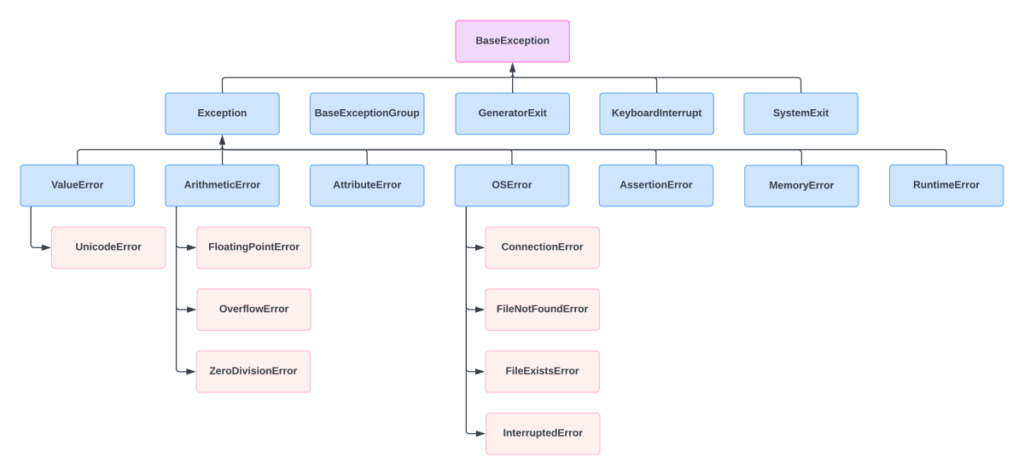Python, as a versatile programming language, comes with a robust error-handling system. One of its core features is the availability of built-in exceptions, which make debugging and error handling more efficient. Understanding these exceptions is essential for writing reliable and maintainable code. This article will dive into Python’s built-in exceptions, their purpose, and how to use them effectively for handling Python built-in errors.

What Are Python Built-in Exceptions?
Python provides pre-defined error types known as built-in exceptions. The program raises these exceptions when it encounters an error during execution Instead of terminating the program abruptly, you can handle these exceptions gracefully using the try-except blocks, which utilize Python built-in exception handling techniques.
Importance of Built-in Exceptions
- Debugging Made Easy: Built-in exceptions provide clear and descriptive error messages, making debugging straightforward, thanks to the effectiveness of Python error handling.
- Error Handling: They allow developers to anticipate and manage errors, ensuring program stability when dealing with Python built-in exceptions.
- Custom Solutions: Using built-in exceptions, you can create custom error-handling mechanisms tailored to your application’s needs.
Common Python Built-in Exceptions
1. ValueError
A ValueError occurs when a function receives an argument of the right type but an invalid value, a common instance of Python built-in exceptions.
int("abc") # Raises ValueError2. TypeError
A TypeError is raised when an operation or function is applied to an object of inappropriate type within Python’s built-in exception framework.
5 + "string" # Raises TypeError
3. IndexError
An IndexError occurs when you try to access an index that is out of range for a sequence in Python, which is handled by Python built-in exceptions.
lst = [1, 2, 3] print(lst[5]) # Raises IndexError
4. KeyError
A KeyError is raised when trying to access a dictionary key that doesn’t exist, representing common Python built-in exception scenarios.
d = {"name": "Alice"}
print(d["age"]) # Raises KeyError5. ZeroDivisionError
A ZeroDivisionError occurs when a number is divided by zero, one of the Python exceptions to be aware of.
print(5 / 0) # Raises ZeroDivisionError
6. FileNotFoundError
A FileNotFoundError occurs when attempting to open a file that doesn’t exist, another instance of Python exceptions.
open("non_existent_file.txt") # Raises FileNotFoundError7. AttributeError
An AttributeError is raised when an attribute reference or assignment fails, showcasing how Python exceptions work.
x = 10 x.append(5) # Raises AttributeError
8. ImportError
An ImportError occurs when an imported module cannot be found or loaded, an example of Python built-in exceptions.
import non_existent_module # Raises ImportError
9. NameError
A NameError occurs when a local or global name is not found, indicating Python built-in exceptions.
print(variable) # Raises NameError
10. RuntimeError
A RuntimeError occurs when an error doesn’t fit into any other built-in exception category, another key aspect of Python’s built-in exceptions.
raise RuntimeError("Unexpected error") # Raises RuntimeErrorHow to Handle Python Built-in Exceptions
The most effective way to handle exceptions is using the try-except block, which is central to managing Python built-in exceptions:
try:
result = 10 / 0
except ZeroDivisionError:
print("Cannot divide by zero!")You can also catch multiple exceptions using a tuple:
try:
value = int("abc")
except (ValueError, TypeError) as e:
print(f"Error: {e}")For specific clean-up actions, use the finally block to ensure proper handling of Python exceptions:
try:
file = open("example.txt")
finally:
file.close()Best Practices for Using Built-in Exceptions
- Catch Specific Exceptions: Avoid using a general
exceptclause unless necessary, to effectively handle Python exceptions. - Log Errors: Always log exceptions to help debug issues later, especially when dealing with Python exceptions.
- Avoid Silent Failures: Don’t suppress errors without addressing them, ensuring proper handling of Python exceptions.
- Document Error Handling: Make sure your error-handling logic is clear and well-documented, particularly the use of Python exceptions.
Conclusion
Python’s built-in exceptions are powerful tools for error detection and handling. By understanding how these exceptions work, you can write robust and maintainable programs that gracefully handle errors and provide better user experiences. Incorporate these exceptions into your code today and take your Python development skills to the next level.
Interview Questions
1.What are Python’s built-in exceptions, and why are they important? (Google)
Python’s built-in exceptions are pre-defined error types that the interpreter uses to indicate errors during program execution. Examples include ValueError, TypeError, and IndexError. They are crucial because they provide a standardized way to handle and debug errors, enabling developers to write robust and error-resistant code.
2.Can you explain the difference between KeyError and IndexError in Python? (Microsoft)
A KeyError occurs when trying to access a dictionary key that does not exist, while an IndexError arises when attempting to access an index that is out of range in a list or tuple. Both indicate invalid access but apply to different data structures
3.How does Python handle exceptions with the try-except block? (Amazon)
In Python, exceptions are handled using the try-except block. The code in the try block executes first, and if an exception occurs, Python transfers control to the except block. This mechanism prevents the program from crashing and allows developers to provide a graceful recovery or a meaningful error message.
4.What is the purpose of the finally block in exception handling, and how is it used? (Meta)
The finally block is used to define cleanup code that must execute regardless of whether an exception occurred or not. It is commonly used for resource management tasks, such as closing files or releasing locks, ensuring the program remains in a stable state
5.Can you describe how custom exceptions differ from built-in exceptions in Python? (IBM)
Built-in exceptions are pre-defined by Python for common error types, while custom exceptions are user-defined classes that inherit from the base Exception class. Custom exceptions allow developers to define specific error types for their applications, making error handling more precise and meaningful.
Learn about Arrays and Detail content about Built in Exceptions
Lets play : Built In Exceptions
Question
Your answer:
Correct answer:
Your Answers
